
| ELEPHANT STREET |
| Text & photographs by Tricky Vandenberg - August 2010 Updated 6 September 2012 |
| Elephant Street ran east of the Grand Palace from Pratu Jakra Mahima (a palace gate) towards Khlong Pratu Khao Pluak and the Elephant Bridge. The street passed Wat Thammikarat, Wat Yan Sen, a canal crossing near the former lead market, Wat Suwan Chedi and Wat Phlaphla Chai. The street would run at present from the northeastern corner of the Palace, through the premises of Wat Thammikarat and Yan Sen, straight over the campus of the Ayutthaya Technical College and continue in eastern direction in between the present Ayutthaya Kinder Garden School and Wat Phlabphla Chai. The street stood in the axis of the present Thanon Pa Maphrao or Coconut Market Rd. Gijsbert Heeck writes in his journal of 1655 [1] the following: At the end of this street [the street of Bazaars], one enters the Street of the Elephants, which, coming from the side, runs straight to the king's court. On both sides this street has nothing but elephant houses, brick-built with strong wooden stalls, named fa. Most stand in duplex, but some are very long buildings in which many [elephants] can be housed together. [1] Johannes Vingbooms gave us a first view of Elephant Street on his - around 1665 published - drawing. We also find an indication of this street on de Courtaulin's map being marked with "Escuries des Elephans" and on Bellin's map with "Rue des Elephans". Coronelli, de La Loubère and de Courtaulin also mentioned the brick stables for the elephants on both sides of the road on their maps. Kaempfer a German medical doctor working for the VOC wrote in 1690: Within the walls of the Palace as well as without, are to be seen long Stables, in which some hundred of Elephants stand in a long row magnificently harnass'd. [2] Phraya Boran Rachathanin indicated on his map drafted in 1926, between the Grand Palace and Wat Phlabphlai Chai the names of three streets covering the whole stretch of the old Elephant Street, being Thanon Na Bang Kra, Thanon Pa Takua (Lead market street) and Thanon Nam Maprao (Coconut milk street). Elephant Street was a brick road which was often used in processions and especially during visits of the King to Wat Racha Burana and Wat Maha That. [3] An embassy sent by King Kirti Sri Raja Sinha of Lanka (Ceylon) arrived in 1751 in Ayutthaya. The embassy resided at the Dutch Settlement and partake in different activities organized by the Siamese Court. Hereunder you find an extract out of the account written by one of its ambassadors during the voyage, regarding their visit to Elephant Street. [4] On the morning of the next day two officers came from the palace and took us on horseback to the town; we arrived at a street one side of which was occupied by two storied buildings and variously gilt elephant stalls; on the other side were similar horse stables. It is impossible to give the number of horses and elephants, male and female, that were here; the street was entirely occupied by the stables and stalls, and there was no dwelling-house at all; we rested in a hall on the side where the horse stables were. Reference: [1] A traveler in Siam in the Year 1655 - Gijsbert Heeck - translated by Terwiel (2008) - page 59. [2] The history of Japan, together with a description of the kingdom of Siam, 1690-92 - Engelbert Kaempfer. [3] อธิบายแผนที่พระนครศรีอยุธยากับคำวินิจฉัยของพระยาโบราฌราชาธานินท์ ฉบับชำระครั้งที่๒ และ ภูมิสถนกรุงศรีอยุธยา (2007) - pages 98-9. [4] Religious Intercourse Between Ceylon and Siam in the Eighteenth Century - P.E. Pieris (1908) - Bangkok Siam Observer Office - pages 22-3. |
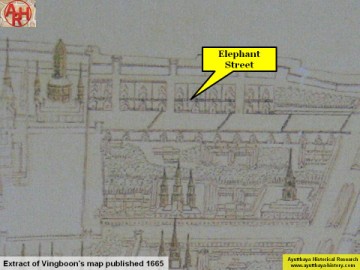
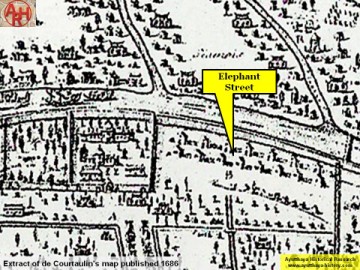
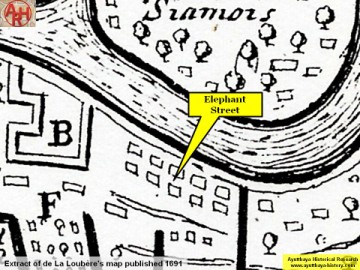
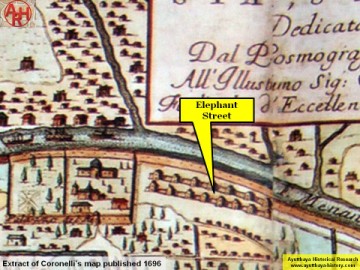
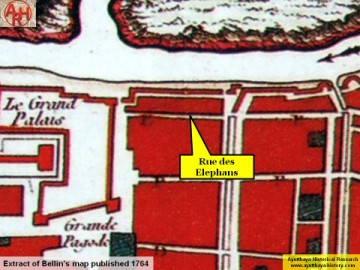
| (Johannes Vingbooms) |
| (de Courtaulin) |
| (Coronelli) |
| (Bellin) |
| (de La Loubère) |